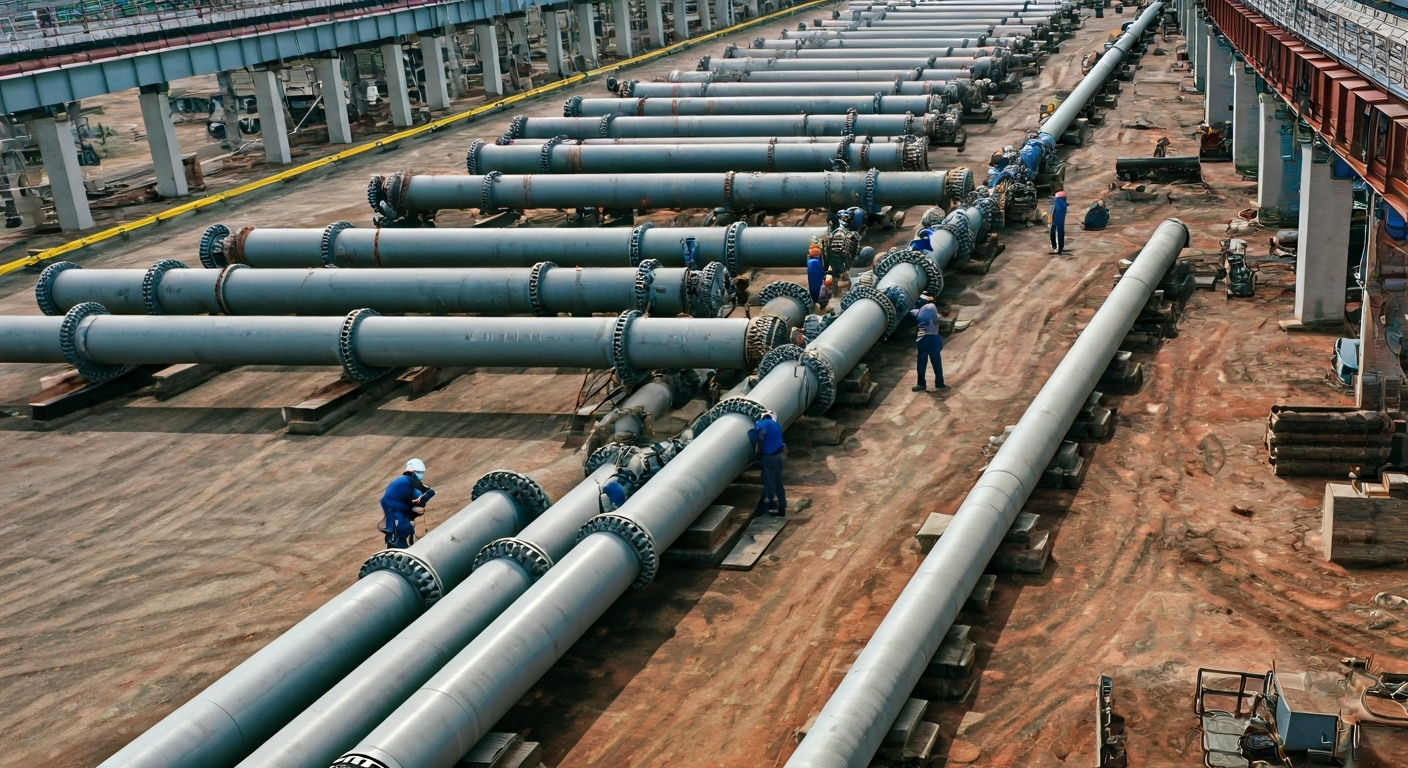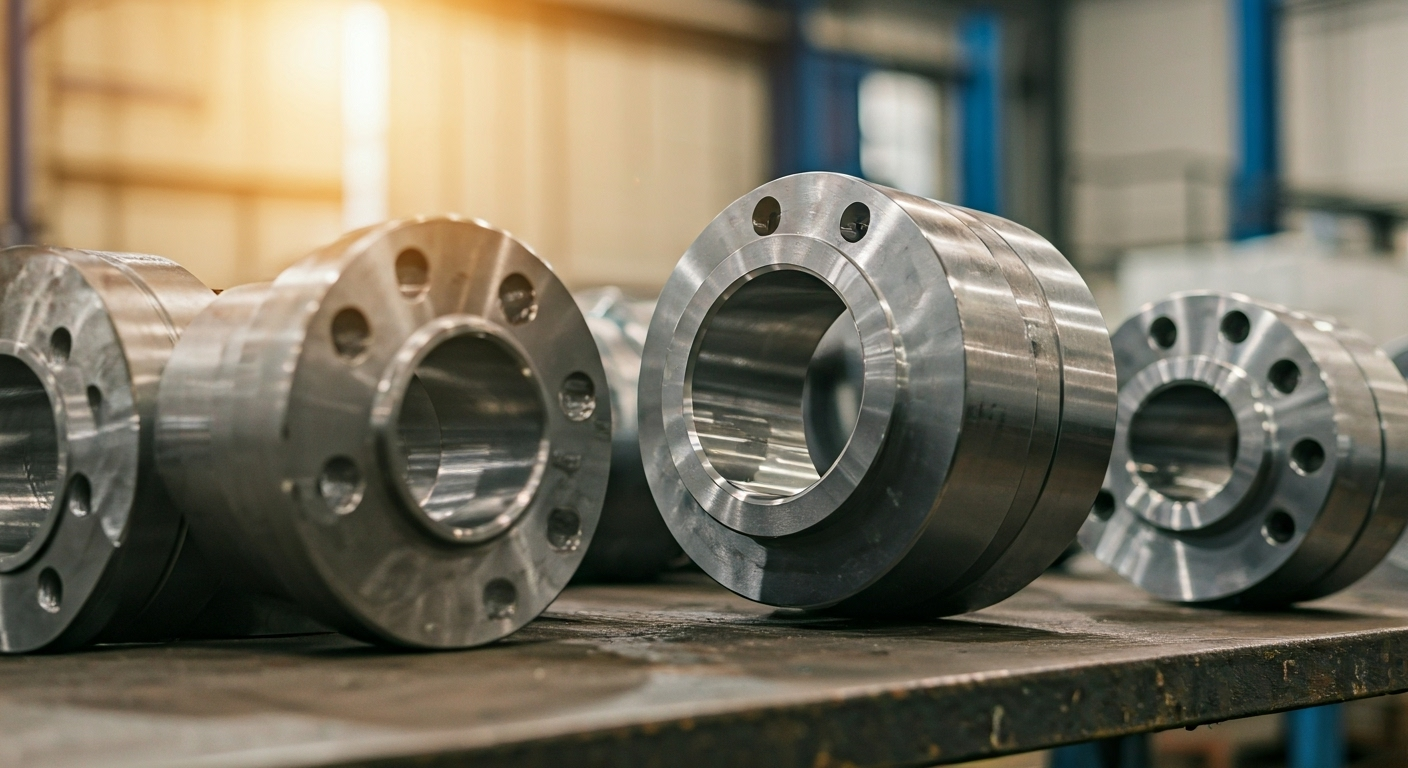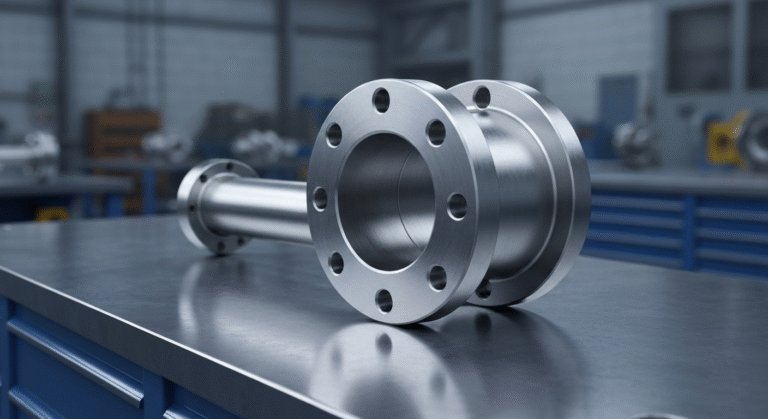-
Zona industrial de Yinzhuang, concelho de Mengcun, cidade de Cangzhou, província de Hebei, China

Flange SO: Considerações chave para instalação e utilização

Principais destaques
- Flanges de encaixe são concebidos para deslizar sobre as extremidades dos tubos e são ligados através de soldaduras de filete na parte superior e inferior, garantindo um ajuste seguro.
- Estas flanges são menos complexas e mais económicas em comparação com flanges com pescoço de soldaduratornando-os populares em aplicações de baixa pressão.
- Fabricado a partir de materiais versáteis como aço-carbono e aço inoxidávelcumprem normas como ASME e ASTM.
- A sua estrutura permite uma vedação eficaz ao lado de juntasque reduzem os riscos de fuga.
- Amplamente utilizado em indústrias como a do petróleo e gás, tratamento de água e processamento químico devido à sua relação custo-eficácia e facilidade de alinhamento.
- Oferecer opções de desenhos de rosto, tais como rosto levantado e junta de anelpara responder a diversas necessidades de aplicação.
Introdução
O Flange SOou flange de encaixe, é uma peça importante utilizada para ligar acessórios e pipa em muitos sectores. As pessoas gostam dela porque é flexível, poupa dinheiro e é fácil de instalar. A flange funciona bem em sistemas com baixa pressão e temperaturas médias. O seu círculo interior é um pouco maior do que o exterior do tubo, pelo que pode deslizar sobre o tubo antes de o soldar. Verá muitas flanges SO no processamento químico, em sistemas de água e noutros locais. São muito utilizadas porque a engenharia é feita com cuidado e podem ser utilizadas de muitas formas diferentes.
Compreender as flanges SO e as suas aplicações

As flanges SO, também designadas por flanges de encaixe, facilitam a ligação de tubos. Vêem-se muito na canalização e em grandes locais de trabalho. O seu design permite-lhe soldá-las por dentro e por fora. Isto ajuda a manter os tubos bem unidos. Isto pode ajudar a evitar fugas. Estes acessórios também se adaptam bem a flanges de tubos de aço. Muitos sítios escolhem-nos quando precisam de peças boas que não custam muito.
É possível obter flanges SO em aço inoxidável e noutros tipos. Isto significa que satisfazem muitas necessidades industriais. Proporcionam encaixes fortes e ajudam a alinhar facilmente as coisas. Funcionam melhor em locais que não têm alta pressão. Ao mesmo tempo, oferecem um excelente desempenho para os seus sistemas de tubagem.
Definição e caraterísticas básicas da flange SO
O Flange SO é um tipo de flange de encaixe que desliza sobre um tubo. É depois soldada à volta dos bordos superior e inferior. Isto ajuda a flange a manter-se estável e cria uma boa vedação. Ao contrário de um flange de pescoço de soldaduraAssim, é mais fácil colocar uma flange de encaixe. O tamanho interior é um pouco maior, pelo que não é necessário alinhá-lo na perfeição.
Estes flanges seguem as regras de grupos como ASTM e ASME. Podem ser utilizados com tubos de ½ polegada a 24 polegadas. Também têm diferentes classificações de pressão, indo até à classe 2500. Pode escolher uma flange SO com caraterísticas como rosto levantado ou um junta tipo anel.
As flanges estão disponíveis em vários materiais, tais como aço-carbonoO aço inoxidável e outras ligas, pelo que podem ser utilizados em muitos trabalhos. São simples de fabricar e instalar. É por isso que uma flange SO é uma boa escolha se precisar de uma instalação rápida e fácil. acessórios. Ajudam a manter os custos baixos e, ao mesmo tempo, são suficientemente resistentes para a maioria das jenis empregos no sector dos oleodutos.
Utilizações industriais comuns na Indonésia
Na Indonésia, as flanges SO são frequentemente utilizadas em locais como a indústria de processos químicos, campos de petróleo e gás e sistemas de água. Empresas como a PT Karya Prima Suplindo oferecem produtos como as flanges SO para satisfazer muitos tipos de necessidades.
Estes acessórios funcionam bem quando se juntam tubos em que a pressão não é elevada e a temperatura se situa num intervalo médio. As flanges SO ajudam a ligar a pipa a bombas, tanques ou outras partes da instalação. São uma parte importante do trabalho em muitas fábricas. Muitas pessoas escolhem-nas porque podem deslizá-las sobre a pipa com facilidade, o que torna a instalação simples.
As flanges SO também se destacam pelo seu bom preço. Normalmente, custam menos do que as flanges de pescoço de soldadura. Pode escolher apenas a flange ou optar por uma flange com um cotovelo ou um T, consoante as suas necessidades na sua fábrica. Se o trabalho exigir acessórios forjados, estas flanges podem ajudar a evitar fugas e fazer com que a sua instalação dure mais tempo do que se utilizar as normais.
Tipos de flanges SO disponíveis

Existem muitos tipos de SO flange jenis fabricados para diferentes configurações na indústria. Dois tipos populares são os face plana e rosto levantado. Cada uma oferece a sua própria forma de vedação e de encaixe com outras peças. A forma como estas flanges são fabricadas depende das normas necessárias, como ANSIou qual a pressão nominal (PN) é necessário.
Desde a simples construção até à melhor vedação, estas flanges são utilizadas para satisfazer determinadas necessidades de trabalho. Conhecer os tipos de flanges ajuda-o a escolher o mais adequado para qualquer utilização. Vejamos de seguida como são fabricadas e qual a importância da escolha do material.
Flanges SO de face elevada vs. de face plana
As flanges de face elevada e de face plana não são iguais. A sua estrutura e a forma como vedam um sistema são diferentes. Uma flange SO de face saliente tem uma pequena parte saliente no lado inferior. Este ponto é utilizado para colocar uma junta. A junta ajuda a impedir as fugas. Estas flanges são boas para utilizar em situações de média a alta pressão.
As flanges SO de face plana, por outro lado, não têm essa parte elevada. A sua superfície é plana. Isto permite uma pressão uniforme entre as duas peças de ligação. As flanges de face plana funcionam bem em locais onde a pressão é baixa e quando um simples aspeto é suficiente.
Tipo de flange | Descrição | Aplicações |
|---|---|---|
Face elevada (RF) | Design elevado para uma melhor vedação da junta | Pressão média/alta |
Face plana (FF) | Estrutura plana; adequada para ligações simples | Sistemas de baixa pressão |
É importante fazer corresponder a flange correta com o sistema correto de classificação LB. Isto pode ajudar a evitar erros durante o trabalho. Também ajuda a garantir que a flange funciona bem em todos os tipos de configurações que envolvam uma junta ou um determinado requisito de lb.
Seleção de materiais para flanges SO
O tipo de material escolhido determina a resistência e a utilidade Flanges SO será. Coisas como ASME As normas e as necessidades de cada sector ajudam a orientar a sua escolha:
- Aço carbono: Esta é uma escolha popular quando se pretende uma opção de baixo custo para tubagens com menos pressão. É frequentemente utilizado no tratamento de água e em instalações químicas simples.
- Aço inoxidável: Este combate muito bem a ferrugem e é ótimo para tubos que transportam produtos químicos fortes ou fluidos agressivos.
Se trabalhar num local com condições difíceis, poderá querer utilizar ligas de aço que sigam ASTM como as normas F11 e F22. O tamanho também é muito importante, com alguns tubos a serem tão pequenos como ½ polegada e outros feitos em diâmetros especiais. Há também certas classificações de pressão a ter em conta ao escolher um material. A indústria tem de ponderar todos estes factores jenis para ajudar a obter um fluxo suave e um menor desgaste das peças.
Principais diretrizes de instalação para flanges SO
A instalação de uma flange SO exige cuidado com o alinhamento das peças, a soldadura e a colocação da junta. Esta flange adapta-se bem aos sistemas de flange de pescoço de soldadura e ajuda a manter a linha forte.
É necessário utilizar bons acessórios para que não haja fugas. Também é necessário seguir os valores corretos de binário dos parafusos para manter o aperto correto. Para o trabalho com as juntas, escolha sempre os melhores materiais para evitar fugas. Cada um destes passos faz com que a montagem funcione bem e dure muito tempo.
Melhores práticas de preparação e alinhamento
Para uma instalação fácil, deve certificar-se de que a flange SO se adapta bem às necessidades da tubagem. Comece por verificar se a flange pode deslizar sobre o exterior da tubagem. Um bom alinhamento impedirá qualquer dano quando soldar as peças.
Depois disto, prepare o cubo. Deve limpar todas as superfícies e retirar qualquer sujidade ou gordura. Isto evitará quaisquer problemas posteriores. Soldar os bordos interiores e exteriores com cuidado para manter a junta forte. Deixe um pequeno espaço entre as extremidades do tubo. Isto ajudará se o tubo ficar quente e crescer um pouco.
Se seguir estes passos antes de começar, a flange SO funcionará muito melhor e durará mais tempo. Também necessitará de menos reparações.
Considerações sobre o binário, a junta e os parafusos
As definições de binário corretas são muito importantes quando se instala um Flange SO. É necessário utilizar ASME regras para o aperto dos parafusos. Isto ajuda-o a evitar aplicar demasiada força na sua flange. Utilize ferramentas corretamente ajustadas, como chaves calibradas, quando apertar os parafusos. Isto permite-lhe obter uma pressão uniforme em toda a volta.
Escolher um bom junta para uma vedação forte. Escolha juntas que se adaptem à flange que tem. As flanges de face elevada necessitam de material de junta mais resistente do que as de face plana. Certifique-se de que utiliza parafusos feitos de metais que funcionam bem com a sua flange para maior segurança e resistência.
Verifique cuidadosamente o binário, o ajuste das juntas e os parafusos. É assim que se mantém a tubagem segura e a funcionar corretamente.
Conclusão
Em suma, é importante conhecer as flanges SO para obter instalações seguras e os melhores resultados em muitas indústrias. Quando se conhece os tipos de flanges SO, os materiais corretos a utilizar e a forma de os instalar, é possível evitar muitos problemas. Isto ajudará os seus projectos a durar mais tempo. Certifique-se de que tem cuidado com a sua preparação e alinhamento. Também deve pensar no binário correto e na junta a utilizar. Isto ajudará o seu sistema a funcionar bem e a manter-se seguro. Enquanto trabalha nos seus projectos, tenha em mente estes pontos principais para obter todos os benefícios que as flanges SO lhe podem proporcionar. Se tiver alguma dúvida ou precisar de mais ajuda, não hesite em perguntar a alguém que tenha os conhecimentos necessários para obter as respostas de que precisa.
Perguntas mais frequentes
Quais são as vantagens de utilizar uma flange SO?
Uma flange SO é boa porque não custa muito e pode ser alinhada facilmente quando é colocada. Proporciona uma vedação forte com a ajuda de juntas. Se compararmos com uma flange de pescoço de soldadura, este tipo de flange é mais fácil de utilizar. Normalmente, é feita de aço-carbono. Uma flange SO é também a escolha certa se precisar de a utilizar em locais onde a pressão é baixa.
Como é que escolho o material correto para a flange SO?
Escolha o material correto da flange SO para o trabalho que precisa de fazer. O aço-carbono é uma boa escolha se precisar de poupar dinheiro. Utilize aço inoxidável se a área tiver muitas coisas que causem ferrugem. Certifique-se de que a flange corresponde às regras ASME e cumpre as classificações de pressão de que necessita. Isto ajuda a que o trabalho corra bem e mantém as coisas seguras.
Os flanges SO podem ser reutilizados após a desmontagem?
Sim, pode voltar a utilizar as flanges SO se não estiverem danificadas. Deve substituir as juntas e verificar se os acessórios apresentam sinais de desgaste. É importante não voltar a utilizá-las sem verificar, pois isso pode torná-las mais fracas e podem não cumprir as normas ASTM.
Quais são os erros de instalação comuns a evitar?
Os erros que acontecem quando se instala uma flange SO podem ser coisas como não alinhar a pipa da forma correta, não apertar os parafusos o suficiente e colocar a junta no local errado. Para evitar fugas ou quaisquer outros problemas, é importante seguir os passos corretos para o alinhamento, utilizar a quantidade certa de força e escolher bons materiais para a flange, a pipa e a junta.
Existem normas específicas para as flanges SO na Indonésia?
Sim, Flanges SO em Indonésia utilizar normas como ASME, ANSIe PN classificações. Muitos sectores dependem de produto que cumprem estas regras. Isto ajuda a manter as coisas seguras e também faz com que os trabalhos de baixa pressão funcionem bem.


